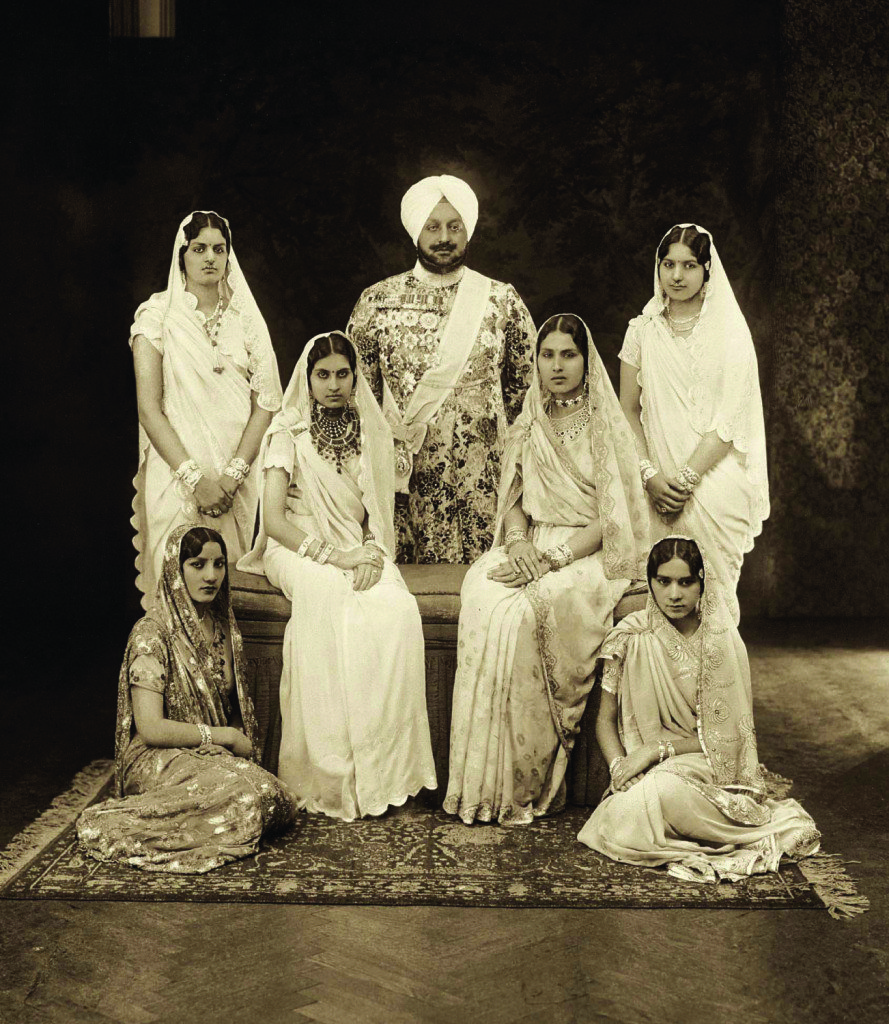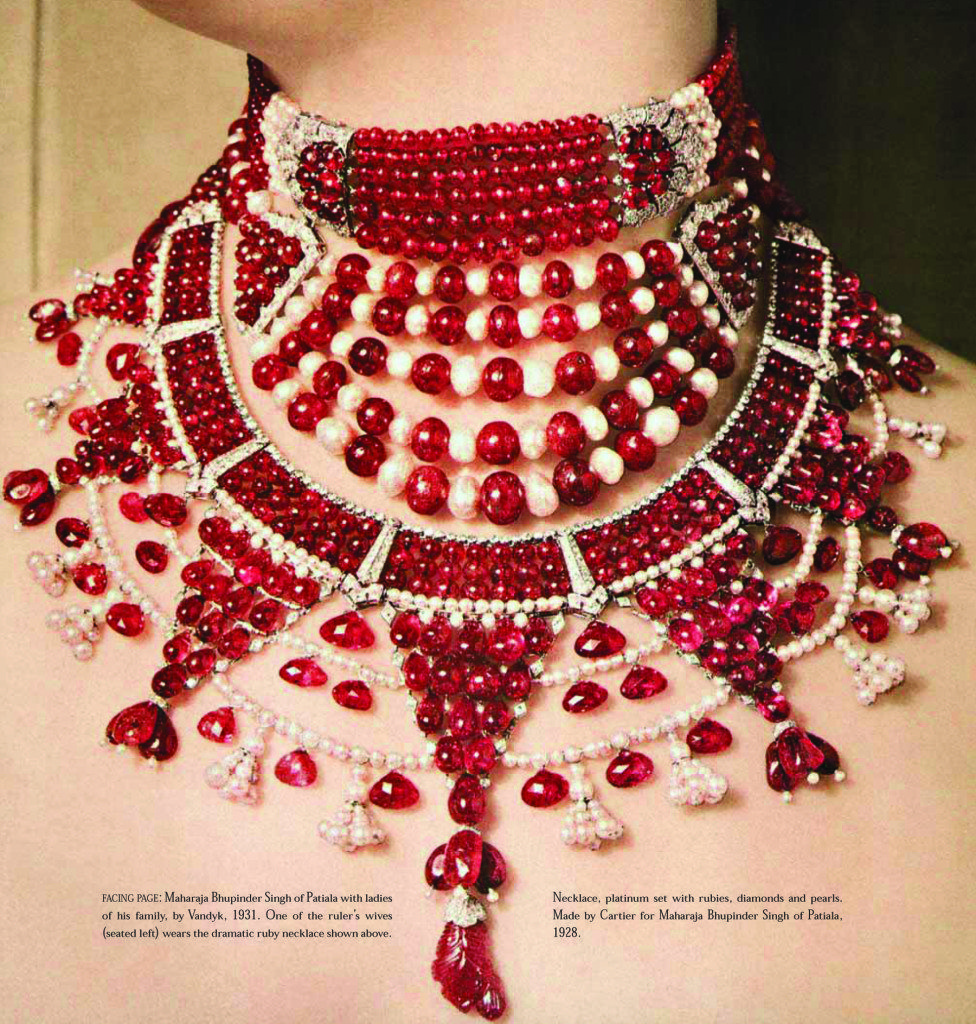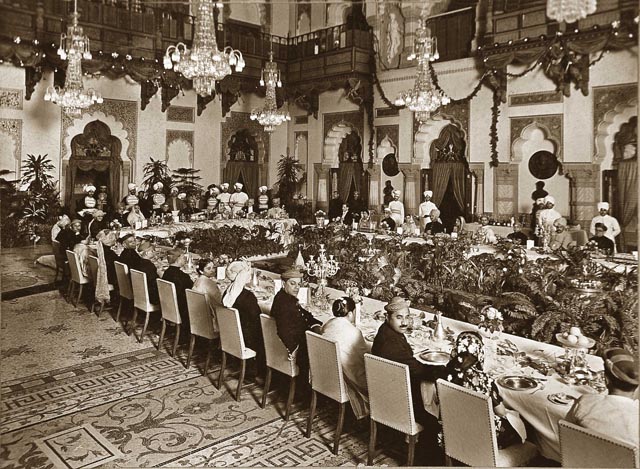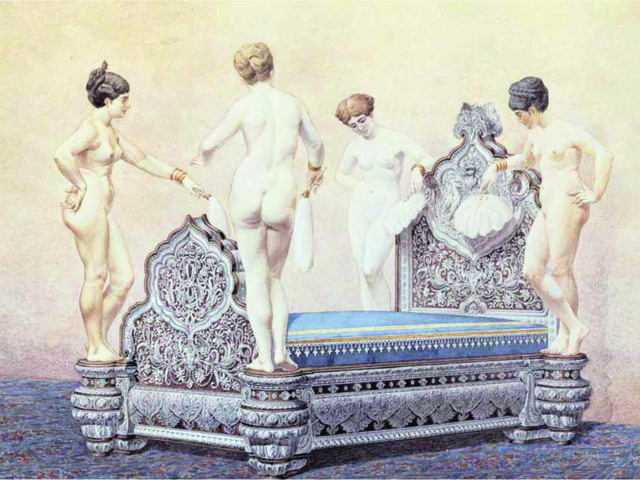10535 people reached on Lassi with Lavina
Cindy Easton, Ann Vix and Tej Gursahan like it on Lassi with Lavina
1313 Views on LinkedIn – 20 Likes – 6 comments

Indian Maharajas, Palaces and Jewels – A Tale of Excess
[dropcap]I[/dropcap]magine this: a rosewood bed encrusted with silver, with four life-size figures of nude women at each corner. Through ingenuous use of mechanics, the statues are capable of waving the fans and fly whisks in their hands – and get this – actually winking at the inhabitant of the bed! Wait, there’s more! The bed is also fitted with a music box that plays a thirty-minute interlude from Gounod’s Faust, when activated by a button.
Pure fantasy? Well, if you were Nawab Muhammad Bahawal Khan Abbasi V of Bahawalpur, it was a definite reality. This bed was commissioned from the firm of Christofle by the Nawab in the 1880’s.
It is just one of the many jaw-dropping extravagances that Amin Jaffer uncovers and documents in the sumptuous book, “Made For Maharajas: A design Diary of Princely India (published by Roli in India and Vendome in the US).
[dropcap]T[/dropcap]he jewels commissioned from major jewelry firms like Cartier, Boucheron, Van Cleef and Arpel are legendary. In fact, Maharaja Bhupinder Singh of Patiala was one of the greatest patrons of Western jewelers. The famous Patiala Necklace designed by Cartier was a five-stranded bib necklace mounted with 2,930 diamonds, with a central pendent of a 234.65-carat de Beers diamond. Indeed, the maharajas had an appetite for every kind of jewelry: when the British refused to let them wear western-style crowns, they simply wore tiaras over their turbans!

[dropcap]A[/dropcap]s the Maharajas lost real power in the British Raj, they became increasingly hooked on to the trappings of power as dictated by the Western world. Major Western purveyors of luxury goods from Cartier to Louis Vuitton to Rolls Royce became their personal catalog houses, as the princes adopted western dress and a western way of living.
“Within one generation of western education, the lifestyle of India’s princes was transformed and they began to wear western clothes, engage in western games and eat western food,” writes Jaffer who is a curator in the Asian department of the Victoria and Albert Museum in London.
The princes created substantial palaces designed by western architects, using elevated western style furnishings and all the trappings of a western lifestyle. They were extremely name brand conscious and they posed for portraits by major names like Man Ray and Cecil Beaton, ate on the best china from Royal Worcester and Minton, drank from Lalique and Baccarat. Trips to London and Paris became mandatory for shopping sprees as the royals bought everything from their wardrobes to their trousseaus from the west.
[dropcap]C[/dropcap]ecil Beaton photographed the beautiful Rani Sita Devi of Kapurthala in a tangerine velvet headdress by the firm of Reboux and a silver fox coat designed by Mainbocher, the American couturier who designed the wedding dress of the Duchess of Windsor. Sita Devi was reputed to be one of the best-dressed women in the world with an innate sense of style and, of course, loads of designer clothes.
To browse through the book is to enter a world of fabled wealth, great eccentricities and flights of fancy that could become concrete reality at a command.
The children of Gaekwar Pratapsinhrao of Baroda went from Laxmi Vilas Palace to the nearby royal school in a miniature train especially made by Royal Locomotives and given by the ruler to his son Ranjitsinhrao as a present on his fifth birthday.

Nawanagar, c. 1939.This car was custom-made
for the young princess but when admired by the young prince of Jaipur,
Bhawani Singh, it was given to him as a birthday present.
Photo: Roli Books
[dropcap]A[/dropcap]utomobiles were another extravagance of the princes that enriched the auto manufacturers. Luxury cars were given as gifts and in trousseaus, and were purchased in quantity. The fleet of the Maharaja of Mysore had no less than 24 Bentleys and Rolls-Royce. Jaffer mentions the many special commissions that the maharajas ordered to fit their lifestyle.
“For instance because he considered it inappropriate for a ruler to appear on the same level as his staff, Osman Ali Khan, Nizam of Hyderabad, commissioned from Barker and Company a car with a special elevated rear seat. Maharana Bhupal Singh of Udaipur overcame this obstacle by simply having his aide-de-camp squat on the car floor.”
Asked when the addiction for Western goods occurred for the princes, Jaffer says: “I think it’s from the very beginning and exotica has always been sought after in any culture. The instant you take something out of the original setting it becomes all the more desirable.”
He points out that foreign goods were particularly attractive because these objects were not as accessible as they are today.. The emperor Akbar was one of the early collectors, fascinated by Western sculpture and paintings as well as Chinese porcelain, which were brought in by Portuguese traders. The fascination for these goods only heightened during the British rule, when the princes had the wealth and the accessibility.
“Not only are these objects extraordinary but they tell so much about the princes and their lives and their own particular stories,” says Jaffer. “Their encounters with the west, their marriages, the things they commissioned for their wives and their houses. It’s clearly documented as well and so it is possible to put together the entire scenario. It’s very, very riveting.”
[dropcap]T[/dropcap]he sheer numbers and extravagances of the princes continually strike you as you turn the pages of this virtual catalogue of desired objects.. Says Jaffer: “The wealth of these princes was so great that it allowed them to run completely free with their imaginations. The cost was really not an object. The sheer volume of jewels in a single necklace, for example, almost defies the imagination.”
He adds, “The numerous luxury houses themselves were very happy to produce these extraordinary items that showed their virtuosity and came with a hefty price tag, and the princes themselves were delighted to see the realization of their dreams.”
As he researched the book, which took him to many countries, which did he feel was the most extraordinary commission? “The thing that really surprised me was the Patiala Commission where the Maharaja of Patiala commissioned Boucheron to make 149 pieces of jewelry for him and at the same time commissioned Cartier to do the same! It’s kind of a complete fantasy to think people were commissioning on that scale. Indeed, during the Great Depression, the substantial commissions from the Indians princes really carried the day for many of the European houses.”
Time changes things: In the 1950’s with the decline of the spending power of the Indian princes, new markets opened up for the luxury houses with the oil wealth of the Middle East and a new group of Russian tycoons.

[dropcap]W[/dropcap]hat’s interesting is that the princes were always an amalgam of East and West, avidly consuming quality items from both cultures. They moved easily between the two worlds and had their Indian persona. An example is the dinner service ordered by Gaekwar Pratapsinhrao of Baroda from Royal Worcester – it was specially commissioned, painted with secular and religious images of Hindu deities.
So if one was to stand back and look – is there any lesson that can be learned from this tale of acquisition? “Well, I think these objects speak volumes about the political relationship between Britain and India and the social position of these princes as well, who were gradually deprived of any real political status or autonomy but who were still permitted shows of extravagance and ceremonial power.”
And the legacy of the Made for Maharaja days? Says Jaffer, “I believe the legacy is a belief in fantasy and a belief in extraordinary high quality and the importance of luxury.”

Were the British dangling these objects even as they took away the power from these princes? As Jaffer points out, they had lost the power in any case so it was merely compensation or a distraction for the princes. Made impotent, they could still conquer the western world with their wealth, and live as well as the rulers could. All these prestige items announced their own self worth, even though in reality they had little power.
Yet do stories ever end or do they tend to get repeated? Is the maharaja phase over or do we now have new maharajas in India – the fabulously wealthy scions of the industrial houses, the tech czars, the Bollywood princes and princesses and the nouveau riche who dress in designer togs and life the million dollar lifestyle? Are the major Western merchants of luxury goods headed right back to India and its new maharajas?
“Oh absolutely,” says Jaffer, “This has something to do with the exotic and the different perspectives and especially the fact that Indians and British have always loved the ceremonial and the grand. Indians have always been a very external culture in terms of brands of luxury houses, and their immediately identifiable designs really meet the needs of the high level Indian consumers.”
And so, after a lull of a few years, we see the luxury houses being back to the lucrative Indian market. Although the book is about luxury goods, it is quite broad based because underlying all the glittering things is the bigger story about the westernization of Indian princes and their adoption of a western way of living and dressing.
Says Jaffer: “So for all of us Indians who live outside India and eventually adopt a western way of life, I think there is a personal connection. The princes are experiencing dual lives in their period of living, and the hybridity of their existence is something Indians living outside India – and indeed inside India today – experience as we become Westernized in this time of globalization.”
Yes, we may not all be able to commission custom-made silver beds with life-size sculptures on every corner from Christofle, but we’ll settle for the new Chanel suit or the bracelet from Cartier any time!
© Lavina Melwani
Photos courtesy: Made For Maharajas (Roli Books and Vendome Press)

9 Comments
Agree – it’s an evocative image – they could all get hired by the best fashion houses in the world! Charisma is the word!
Prachi Varshney via LinkedIn
God I thought it is new pic from Ayush Kejriwal or Sabyasachi collection 🤓
Ashish Tekchandani via LinkedIn
Lovely reading, as always 🙂
Fascinating story – I look forward to your film!
Jyoti Singh Via LinkedIn
My grandmother in that picture. Sitting to the left of Maharaja Bhupinder Singh (my great grandfather) & his fav. Wife, Maharani Bimal Kaur. The film I have made is true story based on their daughters life. Maharani Yadhuvansh Kumari. https://www.facebook.com/yadvithemovie/
Not sure if all of them are wives or women of his family!
Robina Niazi via LinkedIn
This picture of the Maharaja reminds me of Henry the VIII and his wives!
Thank you! Do hope you’ll visit Lassi with Lavina – I have over 1000 articles on everything India-centric – from art to movies to food!
Gurpreet Kaur – via LinkedIn
Interesting article